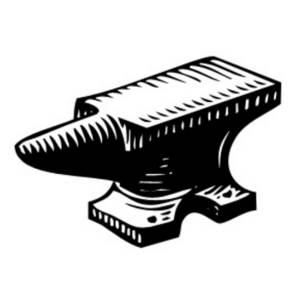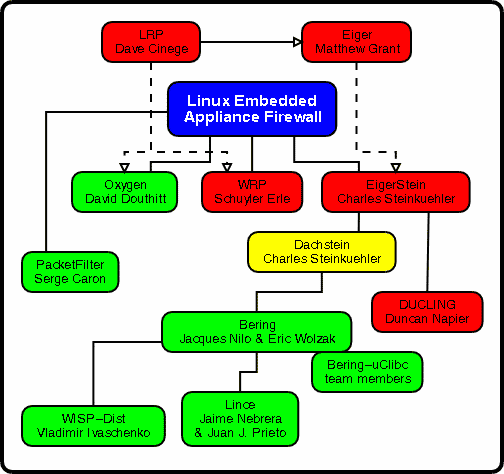 This week I’m speaking with David Brooke from the LEAF project. LEAF is a very small, security-focused distribution of Linux ideal for running on very low-end hardware.
This week I’m speaking with David Brooke from the LEAF project. LEAF is a very small, security-focused distribution of Linux ideal for running on very low-end hardware.
You can subscribe to this, and future podcasts, in iTunes or elsewhere, at http://feeds.feedburner.com/sourceforge/podcasts, and it’s also listed in the iTunes store.
If the embedded player below doesn’t work, you can download the audio in mp3 or ogg formats.
Rich: This is Rich Bowen. I’m speaking with David Brookes from the LEAF project. Thanks for speaking with me today. Could you give us an overview of what the LEAF project is, and what its goals are, and how the project got started to begin with?

David: Sure, Rich. Let me have a go at doing that. I must point out that I’m one of the newbies on the project, so I can’t claim to have been around since the very inception. I’m going to try to speak on behalf of my co-developers, and give a view of what we’re trying to achieve with the LEAF project.
The first thing to say is that LEAF is an acronym. It’s stands for Linux Embedded Appliance Framework. Really those words do capture the essence of what we’re about doing.
Linux, obviously.
Embedded, as in, we do target running Linux on some fairly low-end machines. Right now we are looking only at X86 hardware. That’s what we run on. Pretty much the smallest X86 machine you can think of will happily run the LEAF distribution.
Right now we’re looking at the moment at expanding the supported hardware – CPU chipsets – to run on other devices. The X86 hardware isn’t really at the low end of the scale any more. There are other alternatives that are rather smaller, rather less resource-intensive in terms of power. But right now it’s X86. Really going back a few years when the LEAF project got started up – when it was spawned from other initiatives – it was targeting very low-end X86 hardware, and for a long time we had the ambition of running off of a single floppy disk. So it was fairly a low resource requirement, very small distribution, to fit and boot off of a single floppy, and then run from memory once it had booted, and make efficient use of the kind of hardware that was around, about the year 2000 kind of time scales.
Appliance is that although there’s a focus on firewalling, network routing, that kind of functionality, it is a more generic platform. So really anything you can do with Linux, you can do with a LEAF distribution.
The Framework part of the name touches on that same thing. It is extensible as a framework. It isn’t just for networking and firewalling, although those are focus for it. Other solutions, network based, around file servers, around PBX, voice over IP, other solutions based on the same platform are eminently feasible with the basic distribution.
In terms of what it will do – it will do anything that a standard Linux distribution will do. It is low-end in terms of its demands on resources. Pretty high performance, as best we can get it given those constraints, and pretty flexible.
It is tailored, in its bare distributions, for various network based purposes, but it is extensible beyond that.
R: I saw something on the website about wireless access points. I used to have a flashable WAP. Is it used for that as well?
D: It’s used for that kind of purpose. Not as part of any commercial offerings as far as I’m aware. But if you look at the technology that’s used, I certainly see equivalent componentry in terms of the software applications that run on access points from 3Com, other people, the same kinds of solutions get used that we have available within LEAF. And certainly people are successfully able to build wireless access points.
R: The other thing I noticed on the website is that you mention several forks of your code base, other distributions of it. What’s the philosophy there regarding other distributions of your base?

D: That’s a good question. It really dates back to the early days of the LEAF project – back to about the year 2000. There’s quite a nice diagram on the website that talks about how various projects have merged together and then forked away. One of the initial projects that we based the LEAF solution on was the Linux Router Project (LRP), and personally that’s how I came across LEAF. I initially started about 1999 using LRP to use my own router, and stuck with it for a while. Then I was aware that LRP wasn’t being actively developed, after the year 2000, or maybe 2001, and that the LEAF team were developing LEAF Bering that I then switched to.
There were then various evolutions. What tends to happen is that there’s an initiative to make a fairly major change. For example, there was a change from using conventional libc to micro libc or uclibc, which is now used for the main active branch of the project. These major changes happen, and then things stabilize. The developers and users get to be happy with what’s happening. Then there’s another requirement to change the status quo because maybe people have different ambitions. That’s happened quite recently.
My active involvement has been quite recent. Perhaps the last two years or so, where the version 3 of Bering uclibc was stable, working fine for a lot of people. Based on the Linux kernel version 2.4, which did impose certain constraints. It was constraining some of the functionality, especially around IPv6, and some of the firewalling. And some of the add-on applications were constrained in terms of the versions that were compatible with that 2.4 kernel.
The version 4 of the project now, which has the 2.6 kernel, has caught up with some of the key software components like Shorewall firewall. We were quite far behind in terms of the version of that we were using, and we’ve managed to catch up with that.
What we’ve found is that the footprint of the solution has grown quite dramatically. The 2.6 kernel is a lot bigger than the 2.4 kernel. The new versions of Shorewall actually rely on Perl. It’s a cut-down Perl installation but it is a Perl installation, which is more resource intensive both in terms of disk space and runtime space. That has meant that the aspiration of fitting on a single floppy disk has had to go out the window. But then again, there’s no real user-base out there that relies on floppy disks any more. We’re in a compact flash world, and other physical disk media have taken over.
That was a big change both in the developer community, and in the focus – not so much the focus of the project, but the focus in terms of removing some of the constraints and some of the policies of being very small, and focusing more on performance than on very very small size.
R: Where do you see the project going in coming years? What sort of additional functionality are you going to try to put in there.
D: Functionality-wise, I think we’re already pretty rich. I think in terms of the number of packages, it’s getting on to the 200 individual application packages that are available. We do find that people add to those, so as different developers have a requirement to run a new application, or maybe switch from one bit of technology to another bit of technology, they’ll add another package and grow the functionality that way. That’s organic evolution of extra bits of solution being added on, rounding out the the functionlity available in the framework.
There’s also the change of the lock-in to the X86 CPU set. That’s an active development right now, to go from compiling on X86 for X86 to compiling on X86 for ARM, or other processors. That will open up a much wider range of hardware. And actually rather cheaper hardware. One of the constraints right now is that for the low-power hardware, it tends to be quite expensive. Embedded X86 solutions tend to be reasonably expensive because they’re quite low volume production. Whereas there are other alternatives out there that are a lot more affordable. We’d like to target those. That does give us challenges in terms of the compillation environment. With all of the projects doing cross-compillation, we’re quite sensitive to how the developers of the applications have written their makefiles, and it’s tough to give a completely isolated build environment for some of the applications without the host libraries and other things leaking in. That is going to be a challenge for us to make that switch to a much more clean cross-compillation thing to do. That’s quite a keen thing to do, and I think it will open the project up to a wider userbase, and a wider set of use cases for different applications.
R: It’s always kind of cool for me to see these projects that have been around for ten plus years and are still active. I’m always kind of curious when a project decides that they’re done, and there’s nothing else to do. It’s cool to see that this project is not only active, but still bringing in new developers with fresh ideas.
D: It is cool, and I think that that’s what keeps it alive in some respects. What I’ve found is that the developers – there aren’t that many, we’d like to have more developers, I guess other projects would do – we all seem to have the same kind of ideas, we think the same way about things. As with many of these projects, it’s cool to work with people who have the same kind of ambitions. And we do work well together as a team. We’re quite complimentary in how we focus on different areas, we take responsibility in different areas, and then support each other in other areas.
It almost feels like there have been a number of generations of the LEAF project, handing over from one generation to the next as new developers come on board with new ideas, and the ability to spend quite a lot of time in some cases. Some of the guys devote quite a lot of time to developing the project. There’s a wider community that can benefit from their involvement and investment, and their work.
R: You mentioned that there’s always room for developers. What areas of the project are itching for that new blood?
D: There’s the things that I’ve got on my list:
I think projects always tend to struggle with documentation. That’s certainly one thing that I’ve been trying to contribute.
I’m not really a deep development person. I’ve done software development for about 25 years, or thereabouts. I don’t claim that I’m the world’s best software developer. Because of things I do in my real job, and the things that I do for myself … I’m using a new bit of technology, or a new system, I do tell myself to write down documentation for my own benefit, so that I don’t forget the next time, so I can reinstall something, or understand why I chose to configure things the way that I did. It’s quite a small step for me then to contribute that to the wider community, and write it for a wider audience. So I’ve done some work on the documentation, bringing it up to date for the new version 4 of the project.
We used to use the DocBook technology for our documentation. It’s good technology, but I think it puts quite a few people off from contributing to it. It wasn’t that easy to do a simple change. You had to change a file, and them make sure that it’s complient with the schema and that kind of thing.
We took a fairly bold step, which I instigated, to move to a wiki-based documentation platform, which makes it easier for people to contribute to, and easy to make minor changes to. I think that has proved quite valuable in terms of … I make a minor change if I spot a typo or some slight error I’ll go fix that, as do the other developers as well.
There is quite a lot of documentation. There are quite a lot of undocumented features. There’s quite a lot of packages without any documentation. And I moved across some of the older documentation without doing much in the way of validation of that or improvement of that.
So that’s one area where we can always use new people.
The other thing I’d say is testing. That’s one of our weakness. We don’t have a full test harness. We can do some fairly major surgery to the kernel, or other parts of the distribution, and we don’t have an easy way of checking that it still works for all of the wide range of functionality that we have. I’d be delighted if someone contribute something something more around a formal test harness, or some sort of regression test scripts. Either a very small contribution there, or a bigger contribution, would be pretty neat.
Other things, I’d say, which are open to contribution from other people, is that we were constrained by using the 2.4 kernel for a while. In moving to the 2.6 kernel we’ve had some of the brakes removed in terms of updates of some of the application packages. I’m aware that we haven’t actually gone around all of the packages and done the updates. Right now we are distributing some pretty old upstream application versions. It would be nice for someone to go through and just check on those, which ones are out of date, which ones could be updated.
And then the other thing that we are working on at the moment, that is maybe another top priority, is that there is a web interface for administration of a LEAF system which does give quite a good view of a running system in terms of status. It’s not fully featured in terms of administration updates. I tend to use a command line – I’ll ssh into a box and use the command line menus that we have for administration, as do many of the developers. In terms of entry point for new users, I know that the command line world does tend to put people off, and a lot of the users tend to rely on the web interface. We can always improve on that. I wouldn’t claim that it’s a very advanced web interface. It’s designed for low-power devices, so it’s not that clever in terms of the technology on the back-end. But I know some other projects have got something more flashy on the front end. So there’s some options there for lowering the bar for new users coming on board, because right now it’s not that friendly for a new user. The documentation is helping out in some respects on that, but there’s always more we can do to try and make it real easy for a new user to come on board and get up to speed quickly.
The other core developers … we’re all over the place. This is very much a global project. It’s not the case of there being a small team that has worked together. We’ve all come to LEAF and found LEAF as a good cause to contribute to. We have core developers in Germany and other parts of Europe. Some in the US. I’m based in England. It’s quite good to have people coming from different countries, different cultures, and contributing to the same goal.
The other thing I would say is that I have a day job. I’m not doing this as a day job. I have a day job working in IT. I have a bit of a history in software development. I’m not a developer any more.
One of the reasons I do contribute some time to this project is that it keeps me grounded. These days I’m specifying systems, working with other people, getting teams to do work on my behalf. I’m getting to be the more senior person in my day job. But it’s always good to know where the technology’s at, what’s practical in terms of availability or performance or reliability of solution. Certainly I’ve found that with Linux, it’s a solid platform. I think the industry has now woken up to that. For a while it was seen as a flaky, hobby kind of project, and it’s not the case really. And with LEAF I find that it’s a very stable platform.
Being a developer I do tend to rebuild to new versions pretty frequently, and reboot more often than others would do, but I know that a lot of users have had LEAF running for literally years on end without a reboot. It’s a pretty solid platform. And pretty secure. You can cut it down and be a very limited set of installed files, which therefore makes it quite secure, which is obviously great for a network based security focused installation.
I must thank one of my colleagues based in Germany who felt his English wasn’t good enough to actually speak up on this call. To be honest he does a lot more work on LEAF than I do and he gave me some very useful notes for this session, so I’m plagiarizing some of his comments, and using some of mine as well.
R: Thank you so much for your time.
D: Thanks, Rich, no problem at all. Good speaking with you.
